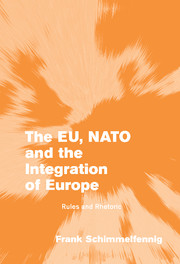Book contents
- Frontmatter
- Contents
- List of figures
- List of tables
- Acknowledgments
- List of abbreviations
- Introduction
- PART I Security, power or welfare? Eastern enlargement in a rationalist perspective
- PART II Expanding the Western community of liberal values and norms: Eastern enlargement in a sociological perspective
- 4 Sociological institutionalism and the enlargement of regional organizations
- 5 Eastern enlargement and the Western international community
- 6 The event history of enlargement
- Conclusion: the sociological solution to the enlargement puzzle
- PART III Association instead of membership: preferences and bargaining power in Eastern enlargement
- PART IV From association to membership: rhetorical action in Eastern enlargement
- Strategic action in international community: concluding remarks
- Appendix (Interviews)
- List of references
- Index
5 - Eastern enlargement and the Western international community
Published online by Cambridge University Press: 22 September 2009
- Frontmatter
- Contents
- List of figures
- List of tables
- Acknowledgments
- List of abbreviations
- Introduction
- PART I Security, power or welfare? Eastern enlargement in a rationalist perspective
- PART II Expanding the Western community of liberal values and norms: Eastern enlargement in a sociological perspective
- 4 Sociological institutionalism and the enlargement of regional organizations
- 5 Eastern enlargement and the Western international community
- 6 The event history of enlargement
- Conclusion: the sociological solution to the enlargement puzzle
- PART III Association instead of membership: preferences and bargaining power in Eastern enlargement
- PART IV From association to membership: rhetorical action in Eastern enlargement
- Strategic action in international community: concluding remarks
- Appendix (Interviews)
- List of references
- Index
Summary
In a constructivist perspective, NATO and the EU are community organizations. Consequently, the first step in the sociological institutionalist analysis of their enlargement is to determine the community culture. I claim that NATO and the EU are regional organizations of the Western international community. The members of this community share a liberal political culture – a postnational identity based on liberal norms of domestic and international conduct. Moreover, both NATO and the EU pursue a moderately exclusive strategy of international socialization that entitles outsider states to become full members only on the condition of advanced internalization. The second step in the analysis consists in showing that NATO and the EU decided to admit the (most) successfully socialized CEECs, indeed.
The Western international community
Both NATO and the EU are organizations of the Western international community which is characterized by three core features. It is an interstate, liberal, and postnational community.
The Western international community is an interstate community. States have established and further developed the community organizations through international treaties. Only states can become members, and it is states that decide whether or not an outsider state is admitted. Moreover, the size or power of political entities is not a criterion for membership as long as these entities qualify as states. States with well below one million inhabitants such as Luxembourg are members of the community; substate regions, let alone cities, with well above that population are not.
- Type
- Chapter
- Information
- The EU, NATO and the Integration of EuropeRules and Rhetoric, pp. 77 - 111Publisher: Cambridge University PressPrint publication year: 2003

